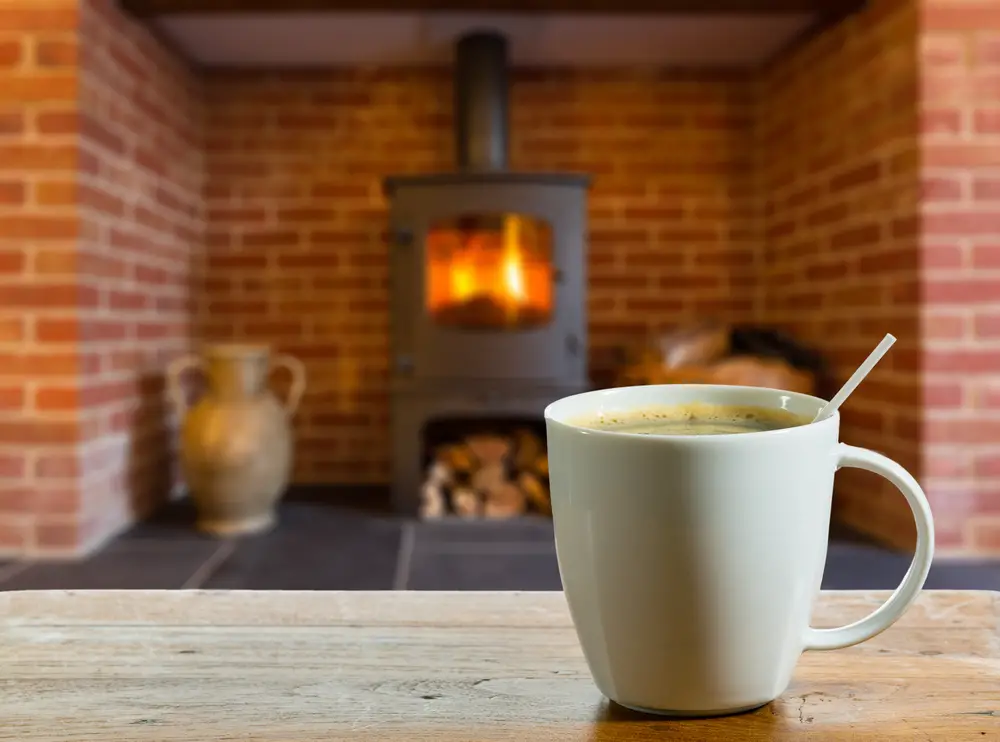During the cold winter months, homeowners often find the wood-burning stove becoming the focal point of their homes, yet the task of finding an appropriate room for its placement can be challenging.
Your living room is the best place to install a wood-burning stove. However, depending on the design of your home, you can place the stove in any other room, including the kitchen. The room in which you install your wood-burning stove should be spacious and well-ventilated.
Read on to find out more about choosing the ideal room for your wood-burning stove and get answers to your nagging questions on this matter.

Can you put a wood burning stove in any room?
You can install a wood-burning stove in almost any room. However, between the appliance and other objects in the room, there must be a minimum distance, as stipulated by building regulations.
The regulations are there to reduce the risk of fires, because a wood stove becomes very hot when in operation. Flammable objects should not be placed too close to the stove.
If you have a multi-floor house and want to use one wood-burning stove to heat rooms on both upper and lower levels, we recommend you get the stove installed on the lower level. This is because heat naturally rises, and moving hot air down via blowers or vents can be tricky.
Where should a wood burning stove be placed in a room?
Once you have determined in which room to place your wood-burning stove, there are further choices to make. Consider placing the stove next to an interior wall rather than an exterior wall. An interior wall is one that separates a room from another room. Placing the appliance next to an exterior wall can result in heat loss.
Put the stove in a corner if that’s convenient for you. If it is far away from the door, lack of ventilation can be an issue. Therefore, make sure there is permanent ventilation in the room. Try not to place the appliance near a stairway. A thermoelectric fan, which has the “Seebeck effect”, can be used to circulate the hot air efficiently.
Living room or kitchen: where should you install a wood-burning stove?
When it comes to choosing a room for a wood-burning stove, the first option is the living room. Another option is the kitchen, which many homeowners find more convenient. Both of these options have their advantages and drawbacks. Let’s dive a little bit deeper.
Installing a wood-burning stove in your living room
As winter sets in, nothing is as pleasant as the warmth emanating from a lit stove. The thought of curling up on the sofa in front of a wood-burning stove is almost irresistible. That’s why your living room may be the best place for your wood-burning stove.
If the living room already has a fireplace with a chimney, installing a wood stove is a pretty straightforward process. However, if the fireplace has not been used for a while, check for the structural integrity of the chimney.
If you replace an open fire with a wood stove, be sure to sweep the chimney about a month after installing the stove, because the combustion difference between the open fire and the stove can cause too much soot. Also, the chimney should be lined with a high-quality, flexible and durable liner.
And if there is no existing chimney in your living room, you can still have a wood-burning stove by getting a twin wall flue system or an external chimney installed. You may have to rearrange the furniture in your living room so that the stove becomes the focal point of the room.
Installing a wood-burning stove in the kitchen
In some families, life centres around the kitchen, and therefore installing the stove in the kitchen is a good idea. if your family members tend to congregate and relax in the kitchen, placing your wood-burning stove in the kitchen is a logical decision
In a typical traditional home, usually there is an existing fireplace in the kitchen. Combining a stove with the original fireplace can make your kitchen a more inviting space. A modern kitchen, however, has no existing flue system. In such a case, you can install a twin flue pipes system.
The pipe can go through an external wall or up through the roof. Whether it’s a viable option for you depends on your home’s structure and layout. Get your kitchen assessed by an expert to know if you can get a twin flue pipe system.
Kitchens are usually smaller than other rooms, and that’s why getting a wood-burning stove installed in the kitchen is not a good idea in many cases. Whether you get your stove installed in the living room or kitchen, just make sure the best out of the appliance.
Factors to consider when installing a wood-burning stove

Prioritize safety when installing any combustion-based appliance. While you can install a freestanding wood stove just about anywhere in a room, it is important to consider the appliance’s proximity to other objects and surfaces in the room.
Observe proper clearances by ensuring a reasonable distance between the stove and combustible objects in the room, such as wood and plastic-based products, carpet, curtains, plasterboard and upholstery.
Also, the stove must be placed on a non-combustible hearth made of toughened glass or stone. The thickness of the hearth must be at least 12 mm. And between the stove and its surrounding walls, keep a distance of at least 150 mm.
Regardless of the dimensions of the stove, the minimum required size of the hearth is 840 mm x 840 mm. Keep a clearing of at least 150 mm to both sides and the rear. The exposed flue of a freestanding stove should also be well-insulated so that the surrounding surfaces are protected from the heat.
Can I put a wood stove in a small room?
Yes you can, but the size of the wood-burning stove matters. The stove you choose should be compatible with the size of the room in which the appliance is installed. If it is a tiny room, don’t make the mistake of buying a large stove. It will be aesthetically unpleasant, and overheat the room.
An oversized stove is also unnecessarily expensive to run. As a rule of thumb, look for the smallest stove that can still generate adequate heat to keep your space comfortably warm.
Follow the installation instructions written in the stove manual, and never violate the clearance guidelines. Even if the combustibles close to the stove are not catching fire now, they will when the stove is hot enough!
Proper combustion will not take place without sufficient ventilation in the room. If it’s a tiny room with no cracks through the doors and windows, the stove may burn weakly for some time and then fill the room with smoke, which can be dangerous. If it’s a relatively airtight room and you have difficulty maintaining a fire, use the direct air kit of your stove.
Also, before you stoke a hot stove, wear a pair of welding gloves. To eliminate the risk of carbon monoxide poisoning (link to Do Wood-Burning Stoves Emit Carbon Monoxide?), get a CO detector installed. Get a fire extinguisher and keep it in an easily accessible place.
Conclusion
Ideally, you should place your wood-burning stove in a room where your family can congregate and relax. In most homes, this room is either the living room or the kitchen.
It’s good to get the stove professionally installed. Make sure the distance requirements are met. Take safety measures seriously and of course, keep combustible materials away from the stove.
